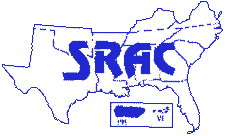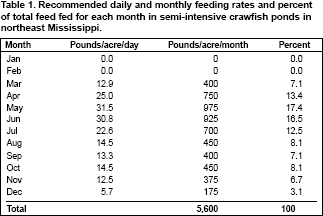
Traditional culture
After flooding, crawfish
emerge from their burrows. The
farmer may choose to harvest
both rice and crawfish or only
crawfish. If the rice is harvested,
regrowth, called ratoon, occurs.
After harvest and as air temperatures
decrease to freezing, the
ratoon or the unharvested rice
dies and begins to decompose.
Bacteria and algae that grow on
decomposing plant material are
consumed by organisms that, in
turn, are food for the crawfish.
Crawfish can be harvested with
traps as early as November, but
are usually harvested from
January through May. Harvest
may end before May in response
to a successful harvest from the
capture fisheries or the need to
plant a new crop. For a more
detailed description of these production
practices, refer to SRAC
publications 240, 241 and 242.
Limitations of traditional culture
Culturing crawfish with planted
forage has helped to satisfy the
increasing consumer demand for
crawfish and to prolong the season
when crawfish are available.
However, when the harvest from
the capture fisheries is abundant,
prices often fall below the level at
which the culture fisheries can
realize a profit. Traditional crawfish
farming has other limitations.
The decay of vegetation in shallow
water can produce critically
low dissolved oxygen concentrations,
particularly when water
temperature is high. Also, food
resources are sometimes depleted
by mid-March or early April,
when the population of crawfish
is largest. As a result, crawfish
cease to grow, or become stunted,
and many of them remain below
market size.
Trapping is the only harvesting
method that can be used in shallow
water that contains vegetation.
Seining is not possible when
vegetation is present. Planted forage
also limits the growth and
harvest period. The pond must be
drained and the crop allowed to
grow before the pond can be
reflooded. If flooding occurs
when water is warm, accelerated
rates of decay will cause the dissolved
oxygen in the water to
decrease to levels that are stressful
or even lethal. If flooding happens
when water is cool, water
quality is not as likely to be a
problem but the cooler water is
not conducive to rapid growth of
the red swamp crawfish.
An alternative culture
Growing crawfish in deeper ponds without planted forage has several advantages over traditional crawfish culture. The growing and harvest seasons are longer; there are fewer problems with low levels of dissolved oxygen; and deeper ponds without forage can be seined to rapidly remove excess crawfish and prevent stunted growth.
Management practices
Pond design and water supply
Ponds should have an average
depth of about 4 feet, range in
size from 1 to 5 surface acres of
water, and have a 3:1 slope from
the top of the levee to the pond
bottom. Long, narrow, rectangular
ponds are more suitable than
wide, square ponds because they
make it easier to distribute feed or
organic fertilizer over the entire
surface area of the pond. There is
also more space for crawfish to
burrow along the perimeter of
long, rectangular ponds. Narrow
ponds also have a larger area of
shallow water that presumably
serves as a nursery or sanctuary
for juveniles.
Either surface or ground water
can be used to fill ponds. The
lower cost of using surface water
must be weighed against having a
reliable quality and quantity of
water. Surface water can contain
predatory fish that compete with
crawfish for the natural food in
the pond. Once ponds are filled,
additional water is needed only to
replace what is lost from evaporation.
Ponds are generally not
drained unless they become contaminated
with fish.
Initial stocking
After the pond is prepared and
filled, it is stocked with broodstock
obtained from commercial
capture or culture fisheries.
Stocking can be done from May to
July. Broodstock generally consists
of an equal number of males and
females. Stocking density should
be 75 to 100 pounds per acre (84
to 112 kg/hectare). Be sure to
stock only crawfish harvested
within the previous 24 hours.
Crawfish held for longer periods
of time are subject to stress and
may have significant post-stocking
mortality. Broodstock should
be transported in mesh sacks and
packed densely enough to minimize
movement. The transported
crawfish should be kept cool and
moist, but not have direct contact
with ice. If sound management
practices that ensure good survival
are followed, crawfish
should not have to be restocked
annually. The unharvested population
remaining in the pond
should be sufficient to sustain
consistent levels of production
from year to year. Restocking is
recommended when annual production
in a pond is significantly
lower than in all other ponds or
when it decreases by 25 to 30 percent
over time. Broodstock should
be restocked at a rate proportional
to the decrease in production.
Feeds and feeding strategies
Existing ponds do not need to
have a food source added before
stocking because natural foods
should be sufficient to sustain the
population until the first young of
the year (those hatched during
successive spawnings of a calendar
year) are produced in mid-fall.
However, new ponds should be
organically fertilized (with
cracked corn, cotton seed meal, or
distillers dried grains) before and
after stocking to ensure sufficient
natural food. Once the initial
young of the year have hatched, a
formulated feed (a combination of
organic fertilizer and feed, or just
a fertilizer) must be added to the
pond to enhance the production of
pond organisms. Both a pelleted,
32% crude protein, sinking catfish
feed and a comparably priced
extruded, 28 to 30% crude protein,
sinking diet have been successfully
used in experimental trials. The
food breaks up rapidlybefore it
is consumedso it mainly acts as
a fertilizer and a source of nutri-
tion for microorganisms that, in
turn, are food for those organisms
crawfish eat. For direct consumption
by crawfish, it is best to use a
highly water-stable, extruded, formulated
feed.
If the price of feed becomes costprohibitive,
alternative methods of
fertilization will be necessary. For
example, two-thirds of the
amount of a sinking catfish feed
might be replaced with alfalfa or
range pellets. Or, commercial feed
could be supplemented with or
replaced by an organic fertilizer
such as corn, alfalfa hay, cottonseed
meal, or soybeans. In recent
research, a combination of rejected
soybeans and alfalfa hay (composite
level of crude protein = 28%)
was substituted for formulated
feed with no significant differences
in production.
The recommended feeding (fertilization)
rates for each month are
presented in Table 1. These
amounts translate into daily feeding
(fertilization) rates of 5.6 to
31.5 pounds per acre (6.3 to 35.3
kg/hectare). These are estimates
based upon the biomass (total
weight) of the pond population
and the water temperature.
Crawfish eat less as water temperature
decreases and eventually
stop eating at temperatures less
than 50 F (less than 10 C), within
its range of tolerance. Crawfish
feed and forage most actively during
the evening. However,
because feeding is essentially a
pond fertilization process, it
should be done in mid-afternoon
when the level of dissolved oxygen
is comparatively high.
Whether feeding (fertilization)
needs to be done every day has
yet to be established.
There are many fertilizers, in a
range of prices, that could be
used. Pelleted feed is easier to distribute
than feedstuffs. Pelleted
organic fertilizers include corn
gluten, rice bran, alfalfa pellets
and range pellets. Organic fertilizer
should be used with care, however,
particularly if the temperature
of the water is high, because
it can dramatically reduce dissolved
oxygen.

Further Information
To continue reading this article, please click here (PDF)
Source: Southern Regional Agricultural Center and the Texas Aquaculture Extension Service - Taken from site - January 2006

